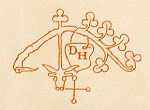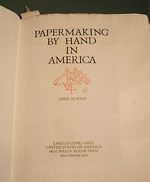A Passion for Paper
It was while Hunter was in Marlborough that the Chicago Society of Etchers approached him about printing its book, The Etching of Figures (1915). Maybe Hunter didn’t set out to make history with that book, but he did, said Baker. He produced the entire book by hand. He milled the paper, designed and carved the typeface, printed, and bound the book. Although Hunter didn’t write the book—William Bradley was the author—it’s still recognized today as the world’s first one-man book.
While it’s true that Hunter had a passion for handmade paper and produced large quantities of it during his lifetime, “Papermaking didn’t really challenge him,” said Baker. “He was the type who wanted to hire the best papermakers and then supervise them.” The same was true of punch-cutting and casting his own type. “If anything challenged Hunter, it was the actual printing process,” Baker said. Once he had mastered a skill, however—and he had mastered every skill related to papermaking and printing—he wanted the actual work to be done by those who did it best.
By 1919, Hunter had returned home to Chillicothe and purchased Mountain House, where he dedicated a first-floor wing to his publishing and printing business, Mountain House Press. During his life, Hunter wrote twenty books on the subject of papermaking—eight of which were published at the Mountain House.
Since Hunter did not put a publisher’s imprint on the title pages of his early books, the only way to identify Mountain House Press books is by his printer’s mark (or device)—a branch and leaf motif with a Bull’s head. Whenever a new book was printed, Hunter would add a leaf to the branch.
Old Papermaking (1923) was the first book printed by Mountain House Press. Hunter’s next book, The Literature of Papermaking, 1390-1800, was completed two years after that. The next Mountain House Press books focused on the papermaking of the Far East. Primitive Papermaking (1927) was the first book in which the Mountain House Press imprint appeared. Old Papermaking in China and Japan (1932) was followed by books on papermaking in Siam and India.
Hunter’s last book was the seminal Papermaking by Hand in America, completed in 1950. With more than 300 pages and 200 illustrations, the book remains the reference for papermakers all over the world. This time, however, instead of increasing the number of leaves on the branch of his printer’s mark, Hunter chose to show a leaf fallen from the branch, an indication that this book would be the last he intended to print at Mountain House Press.
It would not, however, be the last book printed there.
When Dard Hunter died in 1966 at the age of 82, the Mountain House was bequeathed to his son, Dard Hunter II. While Hunter II had grown up with the same reverence for craftsmanship as his father, his art took him in a different direction. He chose to study cabinetmaking through a program at the Winterthur Museum in Delaware. After working for a time as a cabinetmaker for the Duponts, Hunter II returned to Chillicothe, to assist his father at the Mountain House Press.
During the last 15 years of his life, Hunter II began a new labor—a book about his father. The two-volume set he completed, The Life Work of Dard Hunter, was printed in 1981 and 1983. The first volume is 198 pages—194 of which are hand-printed on dark cream paper, handmade in England using Hunter’s watermarked laid moulds. It contains 65 black-and-white illustrations that are hand-tinted to resemble the color of Hunter’s original drawings. The second volume has 25 color and 75 black-and-white illustrations, 34 paper specimens, and 23 title page reproductions.
“That book became my father’s life work,” said Hunter III.
Mountain House
Those who visit Mountain House today will find signs of the papermaking pioneer everywhere.
On a table in the front room, for example, lie large folio copies of both Papermaking by Hand in America and The Life Work of Dard Hunter. The house holds a set of all of Hunter’s books.
Both the front room of the house and the adjoining “Chinese Room” are filled with artifacts and souvenirs of Hunter’s paper-collecting journeys to the Far East. An old Punch puppet sits on a cornice over a door; a pair of skeletons fills a corner in the Chinese Room. Even more arresting, however, are the stained glass panels hanging in the large picture windows of the front room. All of them were made by Hunter, based on Jan Luyken’s Book of Trades.
Inlaid chests and bureaus—made by Hunter II—line the hallway. On the wall up the staircase is a series of illustrations taken from an ancient copy of the Iliad Hunter had purchased in London. Each illustration hangs alongside its copper printing plate.










